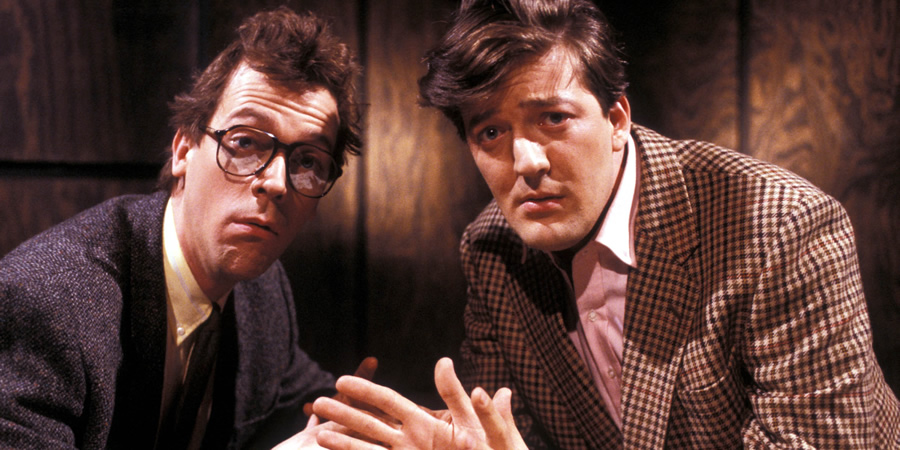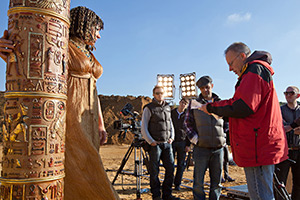Seven great ways of ending comedy sketches

To link in with Chris Head's online sketch comedy writing course, here is a blog from Chris addressing that most challenging part of sketch writing - ending them!
One of the hardest parts of writing a sketch can be ending it! A strong ending elevates the whole sketch whereas a weak ending can let down even a previously strong sketch.
Here are seven great ways of ending sketches with examples from Key & Peele, Fry & Laurie, Amy Schumer, Tim Robinson, Little Miss Jocelyn and CollegeHumor. Use it as a checklist. If you're stuck for an ending work through and try and think of how each one could work in your sketch until you land on one you like.
Here are the ways of ending sketches that we'll be exploring:
Normality restored
Reversal
False dawn
New character
Violence!
Variation
Meta comedy
Normality restored
Here's a simple one to start with. The payoff is an abrupt return to normality after the craziness. This can make for a comical change in tone right at the end. Here the character or characters act as if nothing strange has happened. Here's a great example from the Netflix sketch show I Think You Should Leave With Tim Robinson. In this case the character is unsuccessfully trying to act normally after the madness:
Reversal
A very common ending. The reasonable character suddenly buys into the worldview, or takes on the behaviour, of the unreasonable one. They reverse their position.
There are thousands of examples of this. Here is a great one from Key & Peele. It's the first Substitute Teacher sketch. In this one Mr Garvey is struggling with the pronunciation of the names of his new pupils. The pupils struggle with his peculiar way of saying their names. Right at the end, however, one of the pupils (Peele) confirms his peculiar pronunciation.
And here's another, in the 'If Gandhi Took a Yoga Class' sketch. This great CollegeHumor sketch does exactly what the title promises. Gandhi has been put into a modern yoga class where his 'woke' mat mates are bemused by his authentic Hindu yogic ways and patronise him mercilessly, while he is equally puzzled by the strange turn this ancient Indian tradition has taken. In the ending we see Gandhi, the hitherto voice-of-reason, reversing his position and buying into the thing he has previously been reacting against. In your sketch, if you have a clear voice-of-reason, how about at the end they reverse their position and buy into the other perspective?
False dawn
It looks for a moment like the torment is over for the persecuted character, or the problem is solved, but in fact it isn't. Returning to school, here is a classic example from Rowan Atkinson's live sketch show. The famous Fatal Beatings sketch. The father is shocked to discover that the headmaster has administered a punishment beating during which his son died. The payoff sees the father briefly believing his son is in fact alive and well - before being plunged right back into the madness. His belief that everything was fine is a false dawn. If you have a character being tormented in some way, how about ending the sketch with a moment when it seems like everything is okay... and then it isn't.
New character
If you're searching for an ending, ask yourself: what if a new character enters the scene right at the end? You can play with the fact that we, the viewer, know things that this new arrival doesn't. (Dramatic irony).
Here is an example from Armstrong & Miler. The game of the sketch is that the businessman doesn't know what his job actually is. He just goes through the motions without understanding what he's doing. As a payoff to the scene, a new character enters at the end, a colleague of his. He enters the scene, oblivious to what has been revealed, and we see our original businessman keeping up the pretence.
Here is a different way of using a new character at the end. In this case, the new character takes on the absurd behaviour. It's the Key & Peele school bully sketch where the bully has unexpected insights into the psychological motives underlying his behaviour. At the end, the payoff introduces a new character when the father of the bully shows up in his pickup truck to collect him up from school - and the dad speaks in the same way as the bully. So if you bring in a new character at the end of your sketch they might be unaware of the craziness that has just unfolded - or they might unexpectedly join in with it.
Violence!
If you're really stuck for an ending, you could always have one character hit, attack or shoot another! For all their erudition Fry & Laurie did lots of these (usually with Fry punching Laurie) - and Python did a few too, like the Cheese Shop sketch - but here is one from Little Miss Jocelyn:
And here is one of Fry & Laurie's 'Fry-punching-Laurie' ending - where Fry accidentally punches Laurie for real!
Callback
A very common device in stand-up, this is where something from earlier is unexpectedly brought back - or reincorporated. When thinking about ending your sketch, ask yourself if there is something that happens or is mentioned early on that you could bring back at the end?
Here is another Fry & Laurie one that ends on a callback to a line earlier in the sketch:
In the Amy Schumer Last Fuckable Day sketch, Schumer has it explained to her that 'in every actress's life, the media decides when you've finally reached the point where you're not believably fuckable anymore.'
The ending of the sketch is in three beats - the second of which is a callback. We cut to a different setting later in the day and Julia Louis-Dreyfus is now in a rowing boat. The first gag is a misunderstanding joke. Schumer thinks they are going to kill her with a bow and arrow, but it turns out that what she sees is an oversized novelty lighter, and they are merely lighting her fat celebratory cigar. Then the second beat of the pay-off is a call-back: in this case, the rumour from earlier that Bruce Willis is literally dating a baby lamb is, via a phone update, confirmed as true. Then the third beat to the pay-off has Tina Fey saying she is off to wax her beard. Naive to the last, Schumer strokes her chin and asks when that happens.
Variation
In this kind of ending, the payoff is a variation of the main joke. Here's a delightfully old school style sketch with Harry Enfield and Ronnie Corbett. The game is playing with tech brands named after fruit. The main ones being Blackberry and Apple. The variation ending finds a tech product that sounds like something that isn't fruit. You could try ending your sketch with a variation on the original idea. There's another example of a variation below.
Meta comedy
And finally, if you're really stuck - or are feeling anarchic - you can always go for a meta ending where the artifice of the situation is acknowledged, or the illusion is broken in some way, or the conventions of the performance situation are broken or exposed. Here is an example, again from Fry & Laurie.
In this Fry & Laurie sketch a man has the sound of a lighter being dropped as part of his name. This is a great one to end on because you can see them work through a number of endings. The ending has three beats to it like the Amy Schumer sketch above:
1. Variation - in a variation on the idea of a sound being part of a name, the payoff opens up with a dance as part of his address.
2. Violence - yes, we next have another 'Fry-punching-Laurie' ending.
3. Meta - then finally the meta ending where Laurie comes out of character and tells Fry the punch was too hard and Fry (as himself) comment to camera.
See all of Chris Head's online sketch courses (and sitcom / stand-up)
Chris is the author of Creating Comedy Narratives for Stage & Screen which has extensive material on writing sketch comedy. Amazon
This article is provided for free as part of BCG Pro.
Subscribe now for exclusive features, insight, learning materials, opportunities and other tools for the British comedy industry.



